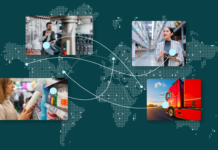Unlike other technology companies that were established in a garage, the origin story of AvePoint is a little different: it began in a public library in Somerset, New Jersey. There, the duo of Dr Tianyi Jiang and Kai Gong coded their first product.
A couple of decades, various acquisitions, and an SG$100 million research facility later, AvePoint is now a global SaaS and data management platform provider with total revenues hitting US$191.9 million last year.
Frontier Enterprise recently spoke with Dr Tianyi Jiang, Co-Founder and CEO, AvePoint, about their technology challenges and goals, the early days of the company, and their new Singapore research facility.
Why did AvePoint choose Singapore as the location for its R&D hub? What will AvePoint research on and develop in this facility?

First and foremost, we chose Singapore as our R&D hub because this has been a market for AvePoint since 2008, where we co-invest and jointly develop SaaS products in conjunction with our partners and customers.
Investing forward and the high appreciation of B2B technology has been the mindset and thinking of many of our Singapore customers, especially in the public sector. In addition, we have observed the vibrant tech community and believe that with our international R&D Hub situated here, we can train and develop more technology professionals, further advance our global trade connectivity, and help drive innovation forward.
Southeast Asia has been dealing with a talent crunch, specifically in tech. How will AvePoint’s Singapore R&D hub help address this shortage?
With the support of IMDA (Infocomm Media Development Authority), EDB (Economic Development Board), and Digital Industry Singapore, AvePoint will hire and train over 500 digital colleagues by 2026, to grow technology leaders in the region. We are looking at growing our existing team of product and technology professionals in roles such as business analysts, data scientists, software architects, and SaaS engineers and securities experts in Singapore, growing up to three times our current size.
You co-founded AvePoint with Kai Gong in 2001. What have been the highlights of your time there so far, and what are the most significant changes you’ve seen since then, specifically when it comes to the cloud and SaaS?
My decision to leave a stable, well-paid job on Wall Street and enrol in a part-time MBA program (and later, PhD studies) came after the life-altering event of September 11th. It was also then that I reconnected with Kai Gong, a friend and former colleague from Lucent Bell Labs, and decided to dedicate my full attention to developing and growing AvePoint with him.
When AvePoint started as a backup solution for Microsoft Exchange, we did not manage to make a single dollar for three years. Sleep, salary, and security were inevitably sacrificed in the journey, and it took over another decade before I could pay myself more than my Wall Street salary. With a lean and mean mindset, we invested every dollar of profit back into the business, to grow into the partner we are today for public and private companies.
We initially relied on the perpetual software licensing and maintenance business model, which is great for building upfront business cash flows. However, as we saw cloud rapidly growing, we decided to fundamentally change the way we did business in 2014 to a cloud-native, cloud-based software-as-a-services (SaaS) business model. This is a major change not only in technology, but also development, operations, and security management methodologies, not to mention the major impact in short-term cash flow on the entire business.
Since going public in July 2021, AvePoint has seen the need for SaaS data management solutions continually grow. Companies are now recognising digital collaboration as integral to their digital transformation evolution and sustained innovation growth. Now, companies are going multi-cloud SaaS, and we continue to meet customers where they are, across platforms like Microsoft, Google Workspace, and Salesforce, all software and services managed and delivered within the cloud.
What made you and Kai Gong come together and start AvePoint? What did you see in the market that was lacking?
We knew that there was no “perfect” moment to take a risk. We had a shared vision to work for ourselves and control our own destinies.
Back in 2001, AvePoint was started from a market need we saw with Microsoft SharePoint customers. People needed a backup and migration path beyond what Microsoft offered for customers using the SharePoint platform for content collaboration and intranet portals, and we filled this gap. That was the need at the time, but if we had just stuck to Microsoft SharePoint solutions and did not evolve, I don’t think we would be the company we are today.
As an entrepreneur, we’re always looking ahead or else we’ll be disrupted. This is especially true in our software industry, where a year is akin to eternity. A ‘test, iterate, and learn’ start-up environment based on a growth mindset culture is the only way to excel in the tech industry.
The end of 2022 is fast approaching. What are currently AvePoint’s top technology challenges? What are its technology goals for 2023?
The demand for stronger data governance, robust hybrid workplace collaboration, and enhanced accessibility of digital services will continue to grow. AvePoint looks forward to:
- Supporting our customers’ needs through product innovation via user-driven SaaS product design.
- Utilising the advantages of the cloud’s scalability and accessibility to keep solutions adaptive to the pace of innovation and evolving business requirements.
For 2023, our key technology investments will centre on employee engagement and change management, as we ride on a growing demand for greater digital collaboration. We want to focus on sustaining connections between people and ensure business resiliency by means of robust analytics capabilities that enable organisations to uncover workplace engagement insights to improve decision-making, optimise performance, and positively impact how people work.
The other strategic pillar of investment is in continuous education, to leverage technology to augment modern collaborative learning experiences for learning as well as professional development. This means working with institutes of higher learning, and corporate learning and development to evolve the way solutions are designed and consumed by modern digital natives as they train, learn, and work to their greatest potential.
As we grow our presence in APAC, especially as we invest heavily in Singapore in the areas of digital talent, infrastructure, and collaboration, we are looking forward to growing our innovation team with tech talent from Singapore through professional development opportunities, to empower local leadership, and invest in collaborative recruitment with local education institutions.
















